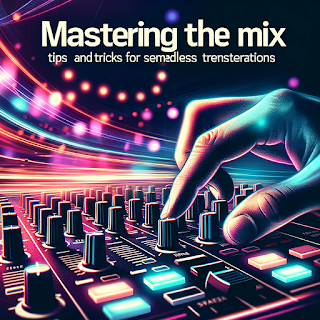Mastering the Mix: Tips and Tricks for Seamless Transitions
As any seasoned DJ knows, the art of DJing is not just about selecting the right tracks but blending them together in a way that feels seamless and natural.
It's about creating a musical journey that keeps the dance floor moving and the energy high. For DJs, mastering the art of transition is crucial.
Here are some tips and tricks to help you ensure your transitions are always on point:
Know Your Tracks: Before attempting any mix, familiarize yourself with the structure of your tracks. Know where the breaks, builds, and drops are. This will help you determine the best points for transitions.
Beatmatching: One of the fundamental skills for a DJ, beatmatching ensures that two tracks are playing at the same tempo. Use your DJ software or controller's pitch fader to adjust the BPM until both tracks align perfectly.
Use EQ to Your Advantage: When mixing two tracks, use the EQ knobs to reduce frequency clashes. For instance, you might reduce the bass of one track while introducing another to prevent a muddy mix.
Utilize Effects Sparingly: While effects like reverb, echo, and filters can add flair to a mix, it's essential to use them judiciously. Overusing effects can make transitions sound messy or overproduced.
Harmonic Mixing: Mixing tracks in complementary keys can result in a smoother and more harmonious blend. DJ software often displays the key of a track, helping you pick the next song that fits harmonically.
Practice Phrasing: Phrasing involves mixing tracks at points where they would naturally change or evolve, like at the end of a chorus or the beginning of a breakdown.
Stay Calm and Adapt: Not every transition will go as planned. If you find a mix isn't sounding right, stay calm, and adjust. Whether that means quickly fading out a track, using the EQ, or introducing an effect, the key is to adapt on the fly.
Record and Review: Regularly record your mixes and listen back. This will help you identify areas of improvement and understand what's working and what's not.
Learn from Others: Attend other DJ sets, listen to mixes online, and see how professionals handle transitions. You can gain valuable insights and techniques to incorporate into your style.
Practice, Practice, Practice: Like any skill, mastering transitions requires practice. Dedicate time to mix regularly, challenge yourself with different genres, and always seek to improve.
In conclusion, mastering transitions is both an art and a science. With the right techniques, tools, and mindset, you can ensure that every mix feels fluid and sounds professional.
Remember, the goal is to keep the energy flowing and the audience engaged, making each transition an opportunity to elevate your set.




Comments
Post a Comment